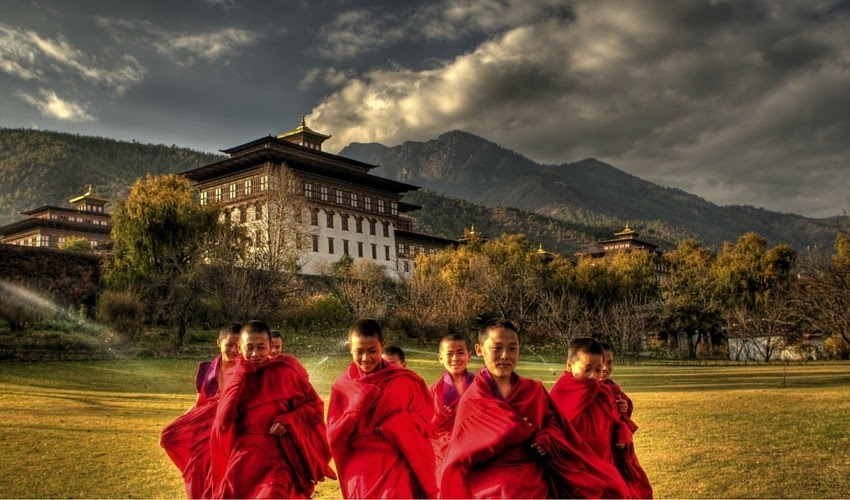Bhutan's Hidden Harmony: An Architect's Unexpected Discovery

Elsie, a 45-year-old architectural historian with a trusty Leica Q2 in hand, had always been captivated by the grand structures of civilizations past. But nothing could have prepared her for the profound experience she was about to have in the Kingdom of Bhutan. This journey wasn’t just about documenting stunning architecture; it was about uncovering a deeper connection between culture, sustainability, and the philosophy of Gross National Happiness. Join us as we delve into Elsie's unexpected discovery, a journey that will forever change her perspective – and perhaps, yours too.
A Cliffside Revelation: The Bumthang Valley
The Bumthang Owl Trek, a challenging but rewarding path through the heart of Bhutan, led Elsie to a remote monastery clinging precariously to a cliffside. Prayer flags snapped in the wind, a vibrant tapestry against the backdrop of the breathtaking Bumthang Valley, with blue poppy fields stretching as far as the eye could see. It was a scene that demanded to be captured.
Using her Leica Q2, Elsie meticulously documented the intricate wood carvings adorning the monastery eaves. Her camera settings, visible on the screen in the video, highlight the precision she employed: Leica Q2, 28mm, f/5.6, 1/250s, ISO 200. She sketched details in her notebook, preserving the essence of the architectural marvel. These monasteries exemplify Dzong architecture, a unique Bhutanese style of fortress-monasteries, which showcases a harmonious blend of functionality and artistry. One of the most iconic examples of Dzong architecture is Paro Taktsang (Tiger's Nest), a must-see for any visitor interested in architectural history.
Capturing the Essence: Leica Q2 and Architectural Photography
Elsie's choice of the Leica Q2 was deliberate. Its exceptional image quality and intuitive design allowed her to capture the nuances of Bhutanese architecture. The fixed 28mm lens forced her to be creative with composition, focusing on how the structures integrated seamlessly with the dramatic landscape. Architectural tours of Bhutan often prioritize the integration of the Leica Camera and the surrounding architecture. She captured low-angle shots emphasizing the scale of the monasteries and carefully controlled the depth of field to draw attention to specific carvings.
Buckwheat Noodles and a Taste of Bhutanese Culture
Beyond the visual spectacle, Elsie sought to immerse herself in Bhutanese culture. A transition to a farmhouse interior reveals her learning to make buckwheat noodles with ema datshi (chili cheese), a staple dish. The warm lighting highlights the textures of the ingredients and the cooking process.

The close-up shots capture her genuine reaction to the spice levels – a mixture of surprise and delight. Food is integral to understanding Bhutanese culture, and Elsie embraced this opportunity to connect with locals on a personal level. Bhutan holidays are not complete without this type of rich experience.
What is ema datshi?
Ema datshi is a traditional Bhutanese stew made primarily of chilies (ema) and cheese (datshi). It's considered the national dish of Bhutan and is a staple in almost every meal. Variations include the addition of green beans, potatoes, or mushrooms.
The Twist: Discovering Gross National Happiness (GNH)
Instead of simply focusing on aesthetics, Elsie unexpectedly started interviewing a local monk about the GNH (Gross National Happiness) philosophy. This conversation marked a turning point in her journey. The monk explained how tourism impacts their way of life and the crucial need for cultural preservation. The discussion highlights how Bhutan balances tourism with cultural preservation.
What is Gross National Happiness (GNH)?
Gross National Happiness is a philosophy that guides the government of Bhutan. It includes sustainable development, preservation of cultural values, conservation of the natural environment, and good governance. This is measured using the GNH Index, and these principles guide sustainable tourism practices in Bhutan. "What is Gross National Happiness Bhutan?" is a common question from those planning to travel to Bhutan. The GNH guiding principles and how they impact Bhutanese architecture can give a deeper understanding of the landscape.
A jump cut shows Elsie haggling (in good spirits) with a local artisan over a handwoven textile, a vibrant example of Bhutanese art and craft. This demonstrates her commitment to supporting the local economy. The final shot zooms out to reveal Elsie’s finished photography display at a local village fair, showcasing her collaborative efforts to help preserve the local culture by providing economic support.

This shift from documenting architecture to actively contributing to cultural preservation is the emotional and intellectual core of the story. The Royal Textile Academy of Bhutan is a key location to observe for those interested in textile preservation.
How can I support local artisans in Bhutan?
- Purchase directly from artisans: Seek out local markets and workshops.
- Choose community-based tourism: Support lodges and tours that benefit local communities.
- Respect cultural traditions: Be mindful of local customs and practices.
An Ethical Call to Action
Elsie's journey is a testament to the power of travel to create meaningful connections and inspire positive change. Her story encourages us to:
- Support Bhutanese artisans directly.
- Travel sustainably.
- Discover the GNH.
Visit Vistalocation.com to learn more about ethical travel experiences in Bhutan and beyond.
Why Bhutan? Understanding Sustainable Tourism
Bhutan's commitment to sustainability makes it a truly unique destination. As a carbon-negative country, Bhutan absorbs more carbon dioxide than it produces, largely due to its vast forests and commitment to organic farming. This dedication extends to tourism, with a focus on minimizing environmental impact and maximizing benefits for local communities. If you are asking "How to travel sustainably in Bhutan?", you are starting with the right questions. Finding sustainable tour operators in Bhutan is a great place to start.
Key aspects of sustainable tourism in Bhutan:
- High-value, low-impact tourism: Bhutan focuses on attracting fewer tourists who are willing to spend more, thereby generating greater revenue with less environmental strain.
- Environmental conservation: Strict regulations are in place to protect the country’s pristine environment, including limitations on construction and waste management.
- Cultural preservation: Tourism policies aim to preserve Bhutanese traditions and values, ensuring that tourism does not erode the country's unique cultural identity.
- Community involvement: Local communities are actively involved in tourism planning and benefit from tourism revenue, fostering a sense of ownership and stewardship.
Bhutan embodies the principles of Sustainable Development Goals (SDGs).
Planning Your Own Journey: Travel Tips for Bhutan
Ready to embark on your own adventure to Bhutan? Here are some essential travel tips:
- Visa Requirements: All foreign tourists, except for Indian, Bangladeshi, and Maldivian nationals, require a visa to enter Bhutan. The visa must be arranged through a licensed Bhutanese tour operator or international partner.
- Best Time to Visit: The best times to visit Bhutan are during the spring (March-May) and autumn (September-November) when the weather is pleasant and clear. These seasons also coincide with many of Bhutan’s vibrant festivals or Tsechu festival. The best time to visit Bhutan for architectural photography will be during these months.
- Currency: The Bhutanese currency is the Ngultrum (BTN), which is pegged to the Indian Rupee (INR). Indian Rupees are widely accepted in Bhutan.
- What to Pack: Pack comfortable walking shoes, layers of clothing, a rain jacket, and sunscreen. If planning on taking pictures make sure to bring extra batteries.
- Respect Local Customs: Dress modestly when visiting religious sites. Remove your shoes before entering temples and monasteries. Always walk clockwise around chortens (stupas) and prayer wheels.
For Bhutan travel tips for first-time visitors, it's best to check reputable travel sites.
What are the best architectural sites to visit in Bhutan?
- Paro Taktsang (Tiger's Nest)
- Punakha Dzong
- Kyichu Lhakhang
- Trongsa Dzong
- Bumthang Valley Monasteries
Conclusion: Finding Harmony in Bhutan
Elsie's unexpected journey through Bhutan serves as a powerful reminder that travel can be more than just sightseeing; it can be a transformative experience that deepens our understanding of ourselves and the world around us. By embracing sustainable tourism, respecting local cultures, and seeking out authentic connections, we can all contribute to a more harmonious and sustainable future. We hope Elsie’s story helps you with travel to Bhutan and inspires you to book a Bhutan architecture tour.